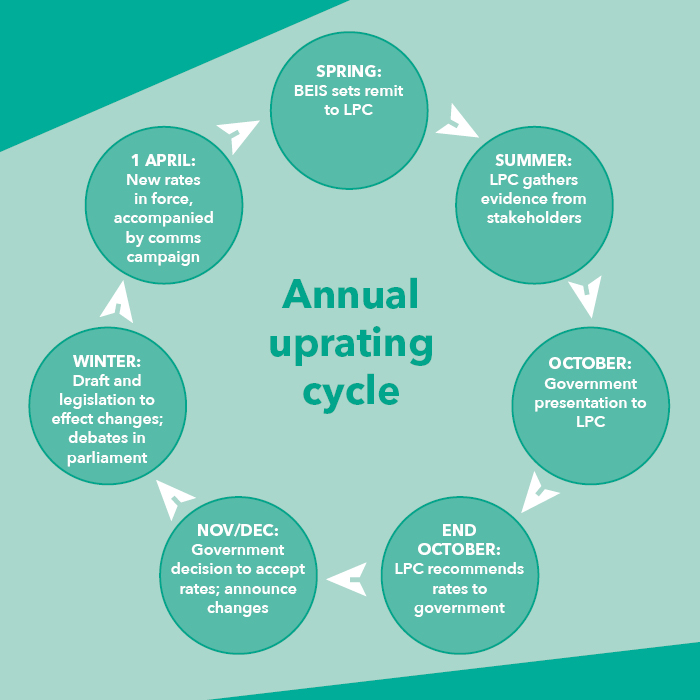Spotlight on: Influencing the Low Pay Commission
The Low Pay Commission (LPC) is an independent public body that advises the Government each year on the rates of the National Minimum Wage (NMW) including the National Living Wage (NLW). The LPC is a social partnership body, made up of nine Commissioners: three from employer backgrounds, three from employee representative backgrounds, and three independents, including the Chair. Every year since its first report in 1998, Commissioners have unanimously agreed the LPC’s recommendations to the Government.
In this latest edition of Spotlight, Rosina Robson, Director of Policy and Public Affairs, blogs about the work the NHBF has done to influence the low pay commissions wage recommendations to the UK Government.
Minimum wage rates for 2022
The Low Pay Commission’s recommendations to the Government on the National Minimum Wage and National Living Wage rates were published alongside the Budget and Comprehensive Spending Review recently. You can view the full report here and here.
The NHBF gave both written and oral evidence to the Low Pay Commission over the summer of 2021. The diagram below sets out the annual uprating cycle, showing how the decision making and consultation process works.

What the NHBF asked for and why?
The NHBF used data from our Members, non-Members and businesses in the sector, drawn from a Wages Survey in May 2021, to inform both our written submissions and oral evidence sessions to the Low Pay Commission. It is really important for our Members to respond to surveys like this as it gives us the invaluable information to represent their voice to Government.
The survey asked about the impact on businesses of previous rises in the rates and the likely impact from future rises, including how they might affect the likelihood of taking on apprentices.
We also used data from the latest State of the Industry survey and the report, Hair, beauty and the pandemic: an industry at the sharp end, an independent report commissioned by the NHBF that set out the impact of the pandemic, business closures and restrictions on the sector. Together, the reports outlined the sector's current economic and business conditions, prospects for recovery, labour market trends such as recruitment and retention, and wage growth and inflation.
We shared data on business debt, whether businesses were breaking even or making a profit, likely to take on staff or apprentices or increase their prices and future growth aspirations or how confident they were about the business surviving.
Our recommendations outlined the need for:
- A moratorium on wage rate increases in the tax year 2022/23 to give the business a solid period of recovery before further increasing costs.
- A commitment to delay the 2024 target to lower the NLW threshold from 23+ to 21+ to at least five years from now to 2026 to give businesses breathing space to recover and adapt following this year's change from 25+ to 23+.
- The target date for the National Living Wage to reach two-thirds of median earnings should be similarly extended to 2026.
- Any future increases to the apprenticeship rate to be balanced against government incentives to employers to encourage businesses to keep on and take on new apprentices and ensure the sector's future.
What the Commission decided
As part of the mandate that the LPC was given by the Government, it was asked to recommend a NLW rate that was consistent with the its target of reaching two-thirds target of median wages by October 2024. In its mandate, the LPC must "advise Government on any emerging risks and, if economic evidence warrants, recommend that Government revise its timeframe or target."
The LPC made the following recommendations:

Why the LPC came to those decisions
Essentially, the LPC reasons that the economic situation has 'improved substantially' and that 'there is good reason to believe the closure of the Coronavirus Job Retention Scheme (CJRS) will not lead to a significant spike in unemployment.’
Unemployment rates are indeed lower at this stage than had been anticipated earlier in the year. However, we know that a section of the population has fallen into the 'inactive' space and that employment and unemployment rates don't necessarily show the whole picture.
The LPC says that few employers are planning redundancies, including small firms where most furloughed workers remained at the end of the scheme. Measures of hours of work have already returned to pre-Covid levels.
The LPC put forward a lower rise in the NMW/NLW because of the economic difficulties in 2020. As a result of what it sees as a better situation, it recommended the Government correct this in 2022 rather than having to make higher rises in 2023/24.
There is no specific analysis in the report accompanying the LPC's letter outlining the potential impacts by sector, i.e. retail, and only a short reference in the report to the recommendations that we, and others, made around the option to freeze rates and delay the rise in NMW/NLW beyond 2024. There is a recognition that there are uncertainties in the pay data.
The LPC also recognises that minimum wage coverage is higher for women, so boosting pay would have a positive impact here. They also recognise the pressures on the childcare sector and the help that rises will bring to low paid parents.

What that means for us looking to next year's round
The Government is moving towards its manifesto commitment of reaching the target of two-thirds of median earnings (a figure that takes many salaries into account and reports the middle number in that set of salaries) by October 2024. The intention also is for 21 and 22-year-olds to move onto the NLW by 2024.
The Government will be asking the Low Pay Commission to advise in 2022 on how it can further achieve these targets, considering the context, economic situation, and labour market in 2022.
There may be a lower rate of increase in some bands next year, given the previous freeze and above-inflation wage increases in some areas this year. However, we would expect a continuation of the trend towards supporting the Government in reaching its previous commitment.
We will make the case again to the Low Pay Commission and the Government, using intelligence and an evidence base from businesses in the sector, including whether there should be future freezes to rate increases or extensions to deadlines.
We will also press the argument that any future increases to the apprenticeship rate should be balanced against government incentives to employers to encourage businesses to keep on and take on new apprentices and ensure the sector's future.
NHBF: we’re on your side
You told us what matters most to you and we will be campaigning at the highest levels on the key issues that affect you and your business, including COVID recovery, tax, wages and apprenticeships.
We are also raising awareness of important industry topics such as employment law, mental health, inclusivity, and sustainability, and providing information and resources to help our Members while making sure their voice is heard at the highest levels.
Join the NHBF today and make the Hair and beauty industries voice louder.

